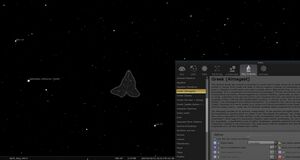Phyllon Kissinou
Phyllon Kissinou
This star name has already been used by modern astronomers and is therefore suggested to be made official. Eric suggested this term, Susanne suggested to use the two terms "kissin" and "phyllon" for two of the three stars that have been associated with the term by Ptolemy.
Etymology & History
Eric mentions the usage for different stars:
- Rhoads (1971) has "Kissin" for 21 Com. Allen (1899):
- Hyde cited some ancient codices as applying to Fl. 21, toward the south, the title Kissīn, a species of Ivy, Convolvulus (bindweed), or perhaps the climbing Dog-rose. This appeared with Ulug Beg, evidently from Ptolemy's κίσσινος, but Ideler said that it was intended to mark c, g, and h, and Baily, that it was for Fl. 21 or 23.
Indeed, the Ptolemy's original wording is φύλλοv κισσίνου (phyllon kissinoy), literally meaning "the ivy leaf". is the shape with which Ptolemy describes the area of Coma Berenices: In his list it is written "the rearmost of them [in the nebulous mass betwween the edges of Leo and Ursa Major, called Coma Berenices], shaped like an ivy leaf". This means he describes the shape of the Coma star cluster as an ivy leaf whose position he indicated with three stars among which 23 Com is the last in his register. Allen (1899) identifies "21 or 23 Com", Rhoads (1971) has "Kissin" for 21 Com but Ptolemy's coordinates fit 23 Com much better (cf. Toomer 1984, Grasshoff 1990 and all research based upon this).
Ptolemy's original text:
Star around Leo outside the constellation:[1]
| numbers | Ptolemy's text translated | identification |
|---|---|---|
| Example | The more avanced of the 2 over the back | (41 LMi) |
| Example | The rearmost of them | (54 Leo) |
| Example | The northernmost of the 3 under the flank | (χ Leo) |
| Example | The middle one of these | (59 Leo) |
| Example | The southernmost of them | (58 Leo) |
| Example | The northernmost part of the nebulous mass between the edges of Leo and Ursa [Major], called Coma [Berenices] | (15 Com) |
| Example | The most advanced of the southern outrunners of Coma | (7 Com) |
| Example | The rearmost of them, shaped like an ivy leaf | (23 Com) |
His problem is that his catalogue only allows to give point coordinates but a "nebulous mass" is not described by a point. Hence, he states that there is an extended nebula with the shape of an ivy leaf and this shape should be drawn by the globe make in a way that it contains the three stars listed. Toomer (1984) identifies these stars as 15 (c), 7 (h) and 23 (k) Com. Although only the last one has the term "ivy leaf" in its description, this term refers to an area that encompasses all three (and possibly even more, fainter) stars.
References
- ↑ Toomer, G.J. (1984). Ptolemy's Almagest, Parlux; Revised ed. edition (19 Oct. 1998)





